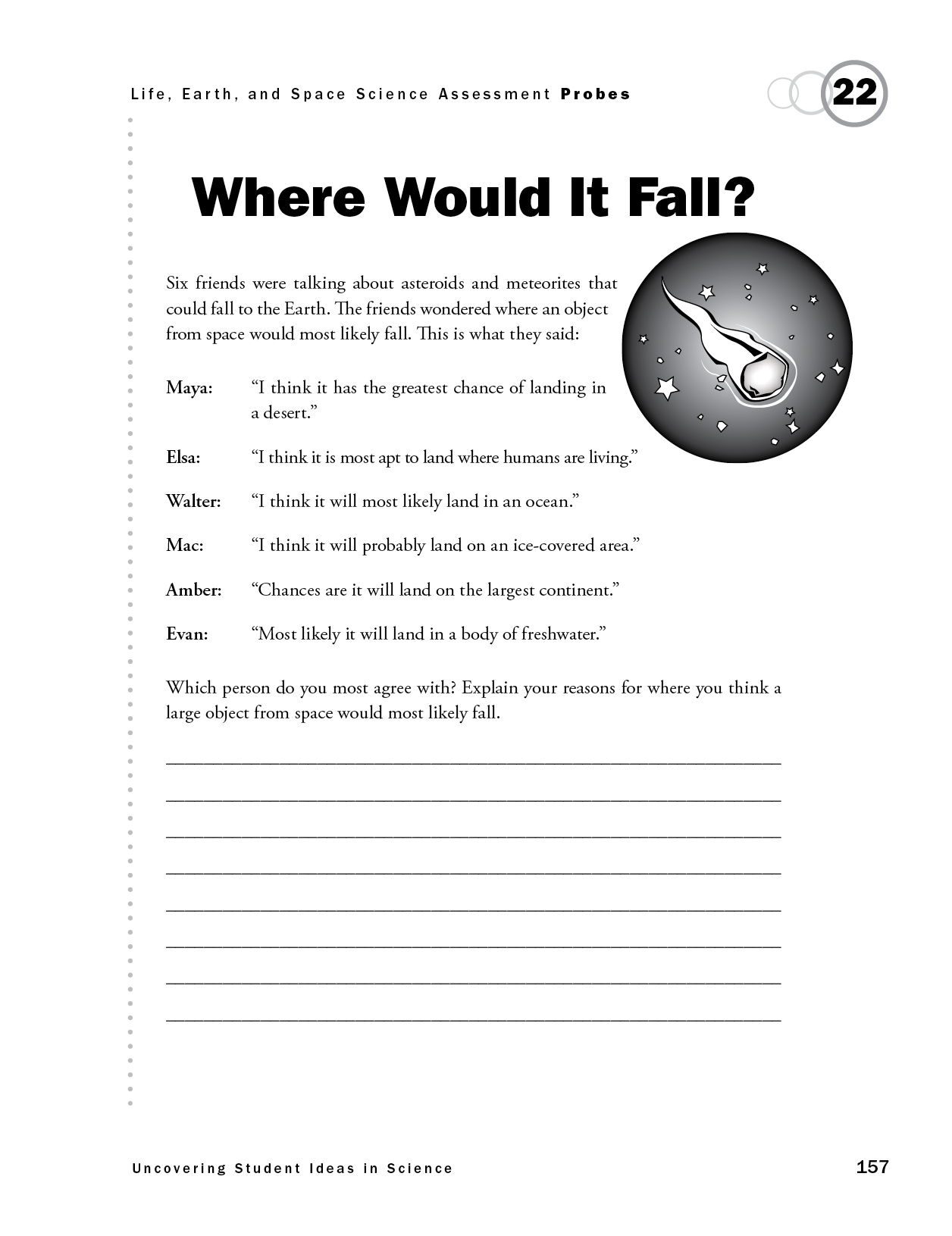Formative Assessment Probe
Where Would It Fall?
By Page Keeley
This is the new updated edition of the first book in the bestselling Uncovering Student Ideas in Science series. Like the first edition of volume 1, this book helps pinpoint what your students know (or think they know) so you can monitor their learning and adjust your teaching accordingly. Loaded with classroom-friendly features you can use immediately, the book includes 25 “probes”—brief, easily administered formative assessments designed to understand your students’ thinking about 60 core science concepts.

Purpose
The purpose of this assessment probe is to elicit students’ ideas about the distribution of land, oceans, freshwater, and ice. The probe is designed to find out whether students realize that most of the Earth is covered by oceans.
Type of Probe
Friendly Talk
Related Concepts
Earth history, Earth’s water distribution, oceans, surface of the Earth
Explanation
The best answer is Walter’s: “I think it will most likely land in an ocean.” Water covers about 71% of the Earth’s surface. Of this 71%, 97% of the water is in the oceans. The probability of the object landing in the ocean is about 69%. Freshwater from glaciers and ice caps covers about 2% of Earth’s total water, with the rest coming from groundwater, rivers, lakes, and other fresh surface waters. About 29% of the Earth’s surface is covered by land. The largest continent is Asia, which makes up about 30% of the Earth’s total land surface. Deserts cover about 20% of the Earth’s land area. About 12% of Earth’s total land area is inhabited by humans.
Curricular and Instructional Considerations
Elementary Students
At the elementary level, students develop an appreciation of Earth’s limited resources. With a developing geographic perspective, they begin to see how much of the Earth is covered by water, although the scale of coverage is not well recognized until middle school.
Middle School Students
At the middle school level, students develop an increased understanding of the distribution of Earth’s land and water resources. Their increased sense of geography and views of the Earth from space help them recognize the oceans as the predominant feature on Earth’s surface.
High School Students
Students at this level have a greater understanding of the global importance of oceans and their distribution worldwide. As they investigate ocean currents and the oceans’ effects on climate, they frequently encounter visualizations that help reinforce their knowledge of the distribution of land and water. However, because students live in a terrestrial environment, they may intuitively think most of the Earth is covered by land.
Administering the Probe
Make sure students understand the context— an object the size of a large rock, falling from the sky and landing somewhere on Earth. Don’t show them a map of the Earth. The purpose of the probe is to examine whether they conceptually understand that most of the Earth is covered by ocean. Showing them a map of the world would clue them to the answer before you have a chance to probe for their ideas about land, ice, and water.
Related Research
- Although we could find no formal research in this area, preliminary field-test results indicated that elementary students believe most of the Earth is covered by land inhabited by people. The notion that the oceans cover most of Earth’s surface begins to be more common in middle school and increases through high school.
Related NSTA Resources
Kelly, C. 2002. The diminishing apple. Science & Children (Feb.): 26–30.
Ford, B., and P. Smith. 2000. Project Earth Science: Physical oceanography. Arlington, VA: NSTA Press.
Suggestions for Instruction and Assessment
- Have students examine a globe or map of the world to see that oceans cover the majority of our planet.
- An inflatable Earth “beach ball” can be used as a model to test this problem. Throw the beach ball 25 times or more. Have each student catch the ball with two hands, looking at what part of the globe the tip of their right index finger is touching. The tip of their index finger will indicate where the object lands on Earth. Have them call out “land” or “water” (include “ice” or “desert” if the ball shows Earth’s features) each time the ball is caught, depending on what their finger is touching. Tally the students’ responses. Probability indicates that most catches will land on water, primarily ocean.

